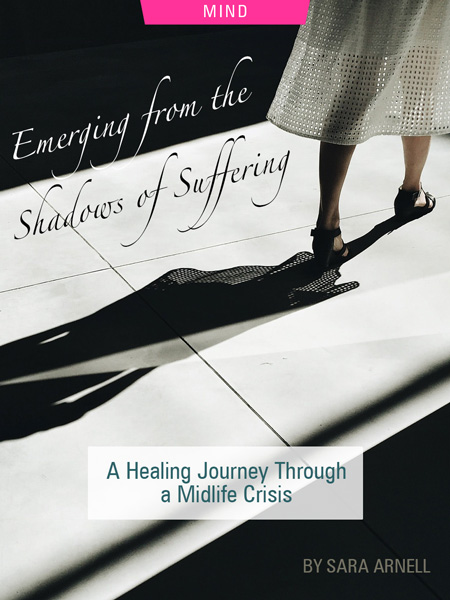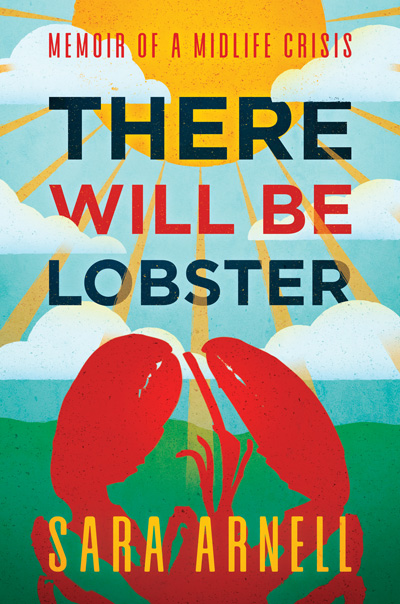Estimated reading time: 7 minutes
A witty, vulnerable, self-deprecating journey of truth-telling and healing — one woman rises from the depths of a midlife crisis
—
One day, I noticed that I had something stuck to my side. I didn’t know what it was, but it slapped me with every step. Step. Smack. Step. Smack. It was getting in the way and slowing me down. My clothes didn’t fit right anymore. My shoulders were hunched from carrying this burden and my eyes were always downward, looking where I was going, as I was so unsure of my footing.
But it wasn’t surgery that I needed to remove this appendage. It was self-esteem. Confidence. Happiness.
This protuberance, this painful weight I was dragging around, was not an actual thing. What was attached to me was more insidious. It was shame. It was regret. It was things I said and did years prior and things I said and did more recently. It was stuff I tried to wash away that never got fully cleansed — like a lingering stain whose shadow remained no matter how many times you tried to scrub it out. These memories, feelings about myself, worry about how I was being perceived, life-changing circumstances and the utter, debilitating depression and loss that came with all of this, stuck to me like glue.
One day I was the CEO of a renowned advertising agency and seemingly the next moment, I was hiding my thirty plus pounds of weight gain under baggy sweaters that covered the top of my too tight, unbuttoned jeans. My pants were always open.
I worried so much about my external perception that I allowed my internal health and wellness to diminish.
I only saw myself as a jobless, directionless, divorced, single, middle-aged mess with a cancer diagnosis, whose last of three children moved out for college. Any good or positive thoughts I had about myself had left the building.
No one noticed I was spiraling out of control. No one noticed I constantly made excuses as to why I had to stay home and not meet for dinner, or anything else. After all, I worked for thirty years in advertising and was very good at showing people only what I wanted them to see. I covered my body under voluminous clothing and hid my emotions behind a fake smile and small talk. Aphorisms and adages from my childhood echoed in my thoughts. Phrases that had been ingrained into my upbringing stopped me in my tracks from telling people what was happening in my life:
Don’t Air Dirty Laundry in Public.
There’s Nothing A Good Night’s Sleep Can’t Fix.
God Helps Those That Help Themselves.
It took a night of drinking and a jolting realization the next morning — along with an unforgettable hangover — that I needed help. The internal worry and stress that were keeping me silent about my pain needed to be released.
I knew I had to start believing that there was no such thing anymore as dirty laundry — that there was only the truth.
I had to get out of bed, wash, dress and wake up to the fact that I couldn’t sleep away my problems. Finally, I had to rouse my own sense of independence and inner strength and know that self-sufficiency didn’t mean that I had to do everything alone; that asking for help is helping yourself.
The lessons my well-meaning mother and grand parents told me to bolster me up and give me confidence were antiquated. They were making me feel solitary, alone and lost. The thing that was slapping my side said I was:
Scared
Useless
Unworthy
Weak
I had to stop myself from believing these things. They were becoming self-fulfilling and holding me back. I had to tell myself a different story. I needed to define myself with new words — new adjectives — that were positive and uplifting.
The story I wanted to write for myself was one of bravery, self-love, truth and healing.
And, why not? Self-pity wasn’t working for me. It was quickly becoming a dead-end. It took me to the edge of a cliff.
I finally saw myself as having to do one thing and one thing only: come out into the open and save myself. All the million things I thought I needed to do to feel better and re-emerge into the world as a vibrant, contributive individual — lose weight, go back to work, spend time with friends and family — fell away when I realized I had one urgent task ahead of me and that was to understand what was true about my life and my being.
So, I began to write, clearly and candidly about how I felt, what I was going through, what I was doing and what I wanted for my life. I was also clear with myself, from the beginning that I wanted my story to help others. And I knew this was important because while I was going through this thing that I called a ‘midlife crisis’, I never felt more alone. I thought that if I told my story and people could read it and take away things that were relevant for them, they would be able to find hope, or solutions or even camaraderie. And I began to think that for me, this was a midlife crisis — but for someone else, it could be a life change crisis, at any age.
Once I decided to share the story of the small, dark room I had locked myself in, I could see light shining under the door.
I wrote story after story about the things that put me in that space. As I released my words into the world, the door began to creak open, little by little. The appendage that was slapping my side shrunk with each loving, forgiving and honest thought I allowed in. It confirmed that we are often the result of what we tell ourselves. It takes facing the tough times of life — the difficult, depleting and depressing moments; the things we wish we said, did or didn’t say or do, to reconcile our truth and start the healing process.
Friends of mine who have read my memoir said to me, “Wow, you did some crazy things.” And my only response is, “I know.” I did do some crazy things. I did do stuff that I’m not proud of, to this day, but that’s OK, because I no longer believe my laundry is dirty. I survived my suffering by being vulnerable, open and honest with myself, about myself. Doing this gave meaning to both my pain and growth.
I have an acute sense of gratitude for the lobster that crawled out from under my kitchen chair one morning. I watched it come out of hiding from whatever drunken madness ensued the night before. I saw myself in this lobster. I was in the same position. I needed to come into the open and save myself too. My memoir, There Will Be Lobster begins with the story of this pivotal moment in my life.
When, through writing, you un-attach yourself from things that have been stuck to you for a long time – like shame, regret and remorse, and put your story out into the world – openly and honestly, the hope is that it crosses the path of even just one person who will benefit from reading it. You hope that when it’s in front of that person, or people, that they recognize why this book came to them. Things that are in front of us are there for a reason. It’s for each of us to notice and try to understand why something has come into our field of vision.
What I hope, for anyone who reads this book, is that it will instigate their own journey to disconnect from the negative stories, painful things that are stuck to them and depleting words that box them in. And then, ultimately, understand how to make the changes they need to find their way forward and write the story they want to be in.
You may also enjoy reading The Beauty of Vulnerability: How Being Vulnerable Can Improve Relationships, by Laura Bishop

